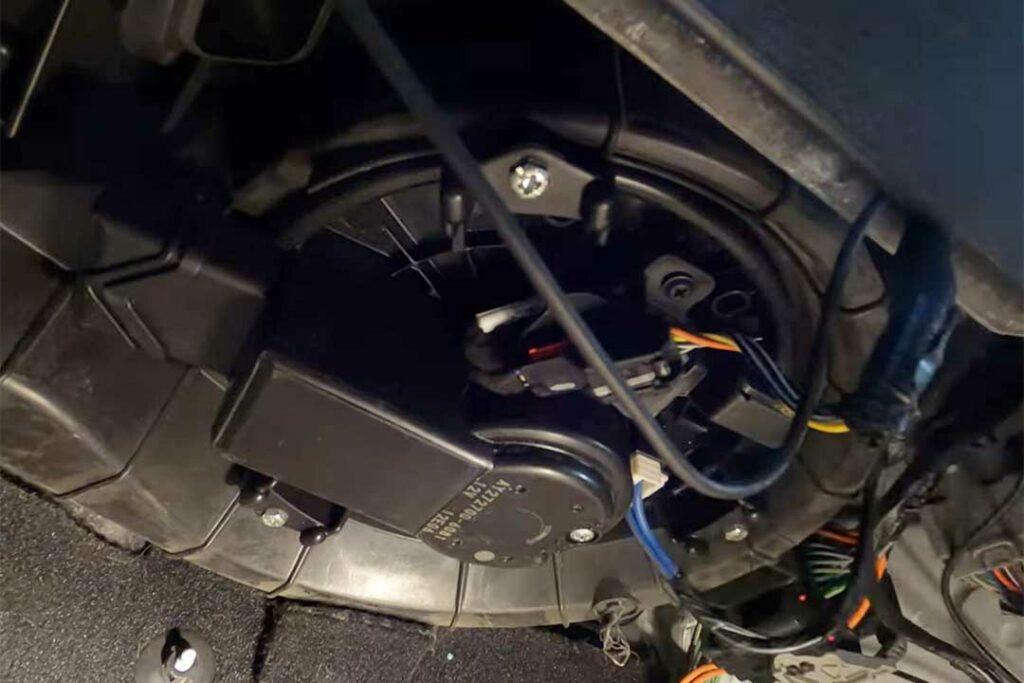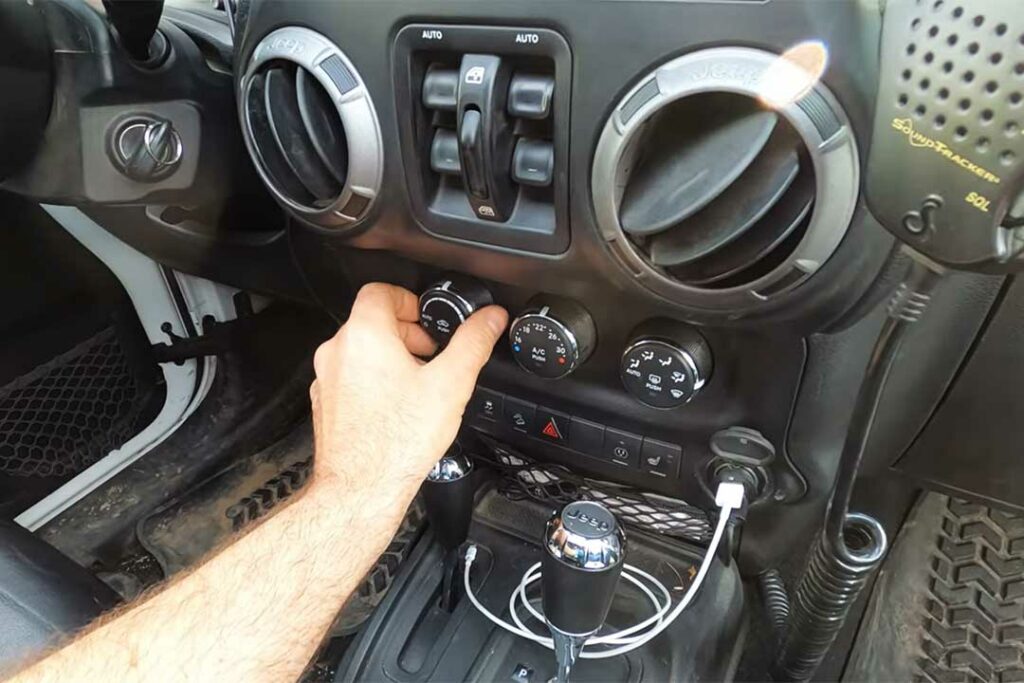Why Is My Jeep Wrangler Blower Motor Not Working? – 7 Easy Fixes
It’s a chilly morning. You hop into your Jeep Wrangler, all set to enjoy a cozy ride, but the Jeep Wrangler blower motor is not working.
The Jeep Wrangler blower motor may stop working due to various reasons, including a blown fuse, a faulty blower fan control switch, a faulty resistor, issues with the heater vacuum switch, a malfunctioning relay, a problematic electrical connector, or motor failure.
To make the blower motor work again, you have to check and replace components one by one, from blown fuses to tricky relays.

In this article, I’m diving into these common headaches that can make your Jeep Wrangler blower motor not work. Let’s discover how to revive that warmth in your Jeep.
Table of Contents
What Causes the Jeep Wrangler Blower Motor to Stop Working?
1. Blown Fuse
The Jeep Wrangler blower motor not working may stem from a blown fuse. This small metal wire is designed to burn or blow when subjected to a high current, acting as a protective measure.
When the fuse associated with the blower motor blows, it disrupts the electricity flow, and because of that, the blower fan motor stops working in your Wrangler.
You can check the fuse block issue with a simple examination – if the metal strip in the middle is broken, the fuse has blown.
For Jeep Wrangler models spanning from 2006 to 2018, pinpointing the fuse block in the engine compartment is easy.
It is located in front of the battery on the passenger side. It features two tabs that you can easily open. Consult your Jeep’s manual for a detailed diagram, description, and location of the specific fuse.
Online resources may also offer insights through images or video explanations tailored to your model about the Jeep Wrangler blower motor fuse location.
Jeep Wrangler Blower Motor Fuse Location:
| Model Year | Fuse Number | Fuse Amperage | Fuse Box Location |
| TJ (1997-2006) | 8 | 30 | Underhood Fuse Box |
| JK (2007-2018) | 1 | 30 | Underhood Fuse Box |
| JL (2019-Present) | 17 | 30 | Underhood Fuse Box |
Get a new fuse and replace the blown one. Ensure it matches the amperage of its predecessor. Properly insert in either direction. Fortunately, the cost of a fuse is negligible.
2. Faulty Blower Motor Speed Selector Switch
If your Jeep Wrangler Sport or Jeep Wrangler Unlimited blower motor is not working, a faulty blower motor speed selector switch, also called a 3-speed fan switch, can be an issue.
Over time, these switches can wear out or even burn due to high voltage, causing the blower motor to malfunction.

To tackle this problem, the solution is to replace the faulty blower motor speed selector switch. This switch is crucial for controlling the blower motor, and a worn or burned one can disrupt its proper functioning. Buy a replacement switch and follow the necessary steps to install it.
To change the blower motor speed selector switch in a Jeep Wrangler, you will need the following tools:
- A Phillips head screwdriver
- A flathead screwdriver
- A Torx bit socket
- A wrench
Instructions:
- Disconnect the negative battery cable.
- Locate the blower motor speed selector switch. You can find it on the central console.
- Pry open the plastic top part of the console panel.
- Remove the screws that hold the plastic cover of the center console.
- Use the Phillips head screwdriver to remove the screws that hold the blower motor speed selector switch in place.
- Use the flathead screwdriver to pry the blower motor speed selector switch out of the center console.
- Remove the connector from the blower motor speed selector switch.
- Use the Torx bit socket to remove the screw that holds the switch to the mounting bracket.
- Remove the blower motor speed selector switch from the mounting bracket.
- Install the new switch in reverse order.
- Reconnect the electrical connector.
- Secure the switch to the mounting bracket with the Torx bit socket.
- Secure the center console’s blower motor speed selector switch with the Phillips head screwdriver.
- Connect the negative battery cable.
- Test the blower motor speed selector switch to ensure it works properly.
Be careful not to damage the wiring when disconnecting the fan switch plug from the blower fan speed switch.
Make sure that the new blower fan speed switch is properly seated in the mounting bracket before securing it with the Torx bit socket.
Test the blower motor speed selector switch on all speeds to ensure it works properly before reconnecting the negative battery cable.
3. Faulty Blower Motor Resistor
If your Jeep Wrangler JK or Jeep Wrangler JL blower motor is not working, a potential culprit can be a faulty blower motor resistor.
It controls the motor’s speed and adjusts it based on your AC fan settings. When this component develops a fault, it can lead to the blower motor ceasing to function properly.
But how do you know if your blower resistor is not working?
You can conduct a voltage test using a multimeter. Locate the blower motor under the passenger side dashboard, remove the electrical connector, and insert the multimeter probes into the connector.
If the voltage reading is abnormal or fluctuates at different fan speed settings, it indicates a potential problem with the resistor.
This step helps you rule out blower motor fuse or relay issues. To do this, you need to know the Jeep Wrangler blower motor resistor location.
The Jeep Wrangler blower motor resistor is typically located under the passenger side dashboard, near the blower motor.
It’s often situated close to the blower motor itself, making it accessible for replacement or inspection.
If the blower motor seems fine, and pressure is not an issue, but the fan motor only works at some speed levels, it can indicate a problem with the resistor.
If this resistor begins to fail, then you will see air blow at only some of the fan speed settings. There will not be any airflow through the Jeep’s vents if the resistor completely fails.
If the resistor is indeed the culprit, replace it. The resistor may get overworked and eventually burn out if the HVAC fan motors are not operating smoothly.
You should replace the old blower motor along with the resistor to ensure optimal functionality.
4. Malfunctioning Heater Vacuum Switch
Consider a malfunctioning heater vacuum switch if your Jeep Wrangler is not blowing air. The blower motor tends to age over time.
As it ages, it can draw more amps, increasing stress on the wiring and switches associated with the motor. This heightened stress can result in overheating and burnout of these components, especially the blower switch.
Assess the malfunctioning control knob. If it has burnt wiring or connectors or is non-responsive, replace it to prevent further damage.
To change a heater vacuum mode selector switch in a Jeep Wrangler, you will need the following tools and materials:
- A new heater vacuum switch
- A flathead screwdriver
- A Phillips head screwdriver
- A Torx bit socket
- A wrench
Instructions:
- Disconnect the negative battery cable.
- Locate the heater vacuum switch. It is typically located on the center console. It is part of the HVAC unit.
- Pry open the plastic top part of the console panel.
- Remove the screws that hold the plastic cover of the center console.
- Use the Phillips head screwdriver to remove the screws that hold the heater vacuum switch in place.
- Use the flathead screwdriver to pry the heater vacuum switch from the center console.
- Use the flathead screwdriver to pry the connector off the heater vacuum switch.
- Remove the screws that hold the heater vacuum switch in place.
- Remove the heater vacuum switch from the HVAC unit.
- Install the new heater vacuum switch in reverse order.
- Secure the new heater vacuum switch with the Phillips head screwdriver.
- Reconnect the connector.
- Reconnect the negative battery cable.
- Test the heater vacuum switch to make sure it is working properly.
5. Faulty Blower Motor Relay
If your Jeep Wrangler blower motor is not working despite a functional fuse, a faulty blower motor relay may be the problem.
A relay serves as an electromagnetic switch in your vehicle, automating the power switching of an electric circuit. A malfunctioning relay can disrupt this automation, potentially leading to blower motor failure.
For many Jeep Wranglers, the relay box is positioned in front of the battery on the passenger side.
Some models, particularly those without a front blower relay, may be controlled by the Totally Integrated Power Module (TIPM) or the AC control circuit board.
Consult your Jeep’s manual for detailed information, including the motor wiring diagram and the relay’s location.
After locating the relay, test it by switching it out for another relay in the fuse box with a similar amp rating. Also, check the relay connector.
Keep in mind that vehicles equipped with auto climate control may not feature a blower motor relay.
Replace the relay if it turns out to be defective. The cost typically ranges between $70 and $80, covering the relay and the mechanic’s labor.
6. Fault in the Motor
When your Jeep Wrangler blower motor is not working, detect the signs of blower motor failure. Unusual whirring noises and inconsistent airflow indicate potential issues.
But, how can you be sure whether it is operating properly? You can test the blower motor by unplugging the blower motor plug, using a voltmeter, and checking the output voltage and resistance.
If a voltage imbalance is detected, directly connecting the motor to a 12-volt battery can confirm its malfunction.
While AC blower motors are generally maintenance-free and can last over a decade, they may fail earlier due to factors like overheating, moisture damage, or manufacturing defects.
Keep an ear out for any unusual noises behind the dashboard, which could signify bearing issues, and be attentive to changes in air pressure during different seasons.
Changing a blower motor in a Jeep Wrangler is a straightforward process that can be completed with basic hand tools. Here’s a step-by-step guide:

Tools and Materials:
- New blower motor
- Phillips head screwdriver
- Torx T-25 screwdriver
- Ratchet with 10mm socket
- Wire connectors
- Electrical tape
- Pliers
Instructions:
- Before starting any electrical work, it’s crucial to disconnect the negative battery cable to prevent accidental short circuits. Locate the negative battery terminal, usually identified by a black or red cable with a negative (-) symbol, and loosen the clamp using a wrench.
- You’ll find it under the passenger side of the dashboard. Open the glove box fully. Remove the screws or clips and carefully detach the glove box. Disconnect any attached lights or liners.
- Once the glove box is removed, you should have a clear view of the blower housing. It’s usually a rectangular housing with electrical connections attached.
- Remove the electrical connectors. There may be one or more connectors. Gently pry the connectors off the blower motor.
- Typically, two or three screws secure the blower motor in place. Depending on the screw type, use a Phillips head screwdriver or Torx T-25 screwdriver to remove the mounting screws.
- Once the mounting screws are removed, gently wiggle the blower motor to loosen it from its mounting brackets and then pull it out.
- Gently push the new blower motor into place, ensuring it’s properly seated.
- Using the same Phillips head screwdriver or Torx T-25 screwdriver, secure the new blower motor by tightening the mounting screws.
- Reconnect the connectors. Ensure the connectors are securely plugged in and make note of their original positions.
- Carefully reinstall the glove box by aligning it with the mounting points and securing it with the screws or clips you removed earlier.
- Reconnect the negative battery cable and tighten the clamp securely once everything is in place.
But if you’re not comfortable doing all this, bring your Jeep to the dealership.
7. Poor Wiring Issues and Connectors
In the Jeep Wrangler’s blower motor system, elements like fuses, resistors, and the motor are not isolated components; they are interconnected through wires and connectors.
Any loose or damaged connection within this network can disrupt the electrical flow, resulting in motor issues. Thoroughly inspect the cables and connectors and ground connection.
Pay special attention to the HVAC panel. A fault here can indeed be the root cause of blower motor failure.
Examine for any burnt, broken, or loose connectors, like on the blower motor, resistor module, or climate control unit. These can interrupt the power supply to the blower motor.
Additionally, corrosion or a damaged wire in the circuit, including the one from the fuse box, can be why your Jeep Wrangler blower motor is not working.
Rodents like rats or mice can get into your vehicle, even the dashboard, chewing on wire coatings. This mischief can result in various electrical problems, including issues with the blower motor.
If you spot evidence of bite marks, proceed with a meticulous examination of all cables and hoses.
Read More:
- Service Forward Collision Warning: 11 Common Causes And Fixes
- Service Electronic Parking Brake: 8 Common Causes And Fixes
Final Words
Your Jeep Wrangler’s blower motor has stopped working because of problems ranging from a malfunctioning motor, HVAC switches, faulty resistors, or poor wiring and connectors, which can manifest in symptoms like inconsistent airflow, unusual noises, or a complete lack of ventilation.
To address these issues, check the fuse, switches, relay, resistor, and motor. If you find these tasks challenging or prefer not to undertake them, I recommend taking your Jeep to the dealership for professional assistance.
